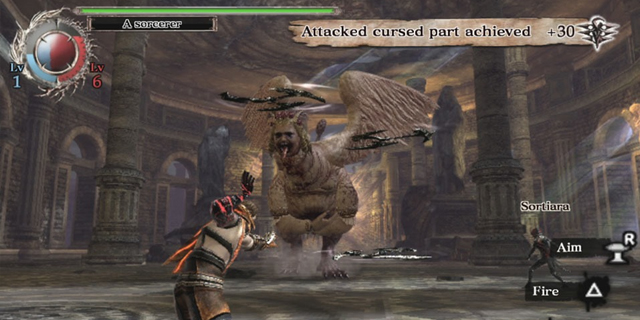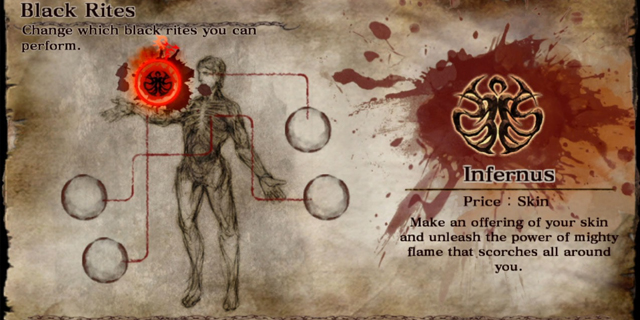
Soul Sacrifice does what few games do. It carries a theme, clings to it, spreads it throughout all of the bits and pieces that make up a video game: a medium that tells a story not only through blatant exposition, but also the personal experience a player has when physically interacting with its world. Soul Sacrifice demands much of the player, and forces tough choices: not just good versus evil, but risk versus reward. The ramifications of your choices, your sacrifices, go beyond altering your ending or your flavor text. They also define the way you play the game.
You are a human sacrifice, living fuel for an immortal sorcerer gone bad. In a prison comprising rotting flesh and bone, you discover an ugly, talking book. He offers to give you the tools you need to escape by living vicariously through a sorcerer of the past. What ensues is a game not unlike Monster Hunter or Ragnarok Odyssey. You choose missions within the macabre pages of the flesh-bound book, and spend the majority of your time fighting monsters ranging from grunt status to screen-filling.

Combat plays out like your standard third-person action masher, with a twist. Being a sorcerer, you fight using your finite magic supply. For each action you take, you must make an offering. A sacrifice. Merely summoning a sword requires the use of an artifact, and drawing power too liberally will break it. You have two sets of three slots that you can access with a tap of the R button, and you will have access to dozens of artifacts to choose from: weapons, shields, healing spells and more, all with varying elemental properties. Fusion and upgrades also play a large part in managing your arsenal.
During a mission, certain points on the map can also be used to create tools on the fly. Of course, these expire after one use, so you must achieve a balance between using what you have and what you find without cleaning yourself out. Each map also has one point that restores your artifacts a little. Figuring out the best time to make use of that can be tricky, especially in multiplayer combat.
Soul Sacrifice‘s cooperative play is all about making careful choices. You can save a dying ally, but you give up a large portion of your health in the process. You can also sacrifice them, reducing them to a supporting role but powering yourself up. Non-damaging, but combo-interrupting friendly fire is also in effect, so awareness of your surroundings is paramount lest you waste your precious spells.

Saving or sacrificing also plays a part when fighting enemies. When you beat a monster, it reverts back to its harmless original form. You can save it, restoring your health and boosting your defense, or sacrifice it to increase your attack power and restore your artifacts. Unsurprisingly, heavily leaning either way unlocks specific sets of skills. You can also go for balance, offering even more possibilities.
In the most dramatic, but also somewhat disappointing, manifestation of the sacrificial theme, you can sacrifice literal parts of your character’s body, giving you a huge boost or enormous attack but permanently handicapping you in the process. You can, for example, offer your skin for a great boss finisher, but for the remainder of the game your defense is cut in half. Unfortunately, this mechanic is perhaps a little too risky, which the game recognizes. You can collect “lacrima,” a substance produced by the book, that allows you to take back certain choices, repair overworked artifacts and even retcon your sacrifices in order to rework your skill progression. It is certainly optional, but you are awarded with enough lacrima to never be in danger of running out, which more or less ruins the point of the game. Soul Sacrifice tries to cheat a bit here, to have its cake and eat it too, and it serves to cheapen the experience even if you don’t use it.
Soul Sacrifice may be a touch unremarkable against its peers taken at face value, but it is respectably ambitious. Designed around a gimmick, it succeeds in weaving the gimmick into the game in such a way that it feels natural and unique. The way the game tells its story — not only through sitting and watching cutscenes, but also through your progression as a player — is refreshing. It goes well beyond most games with standard moral choice systems in making each decision you make, no matter how minor, reverberate through the rest of your personal narrative.
Pros: Aesthetics blend seamlessly with mechanics
Cons: Combat doesn’t stand out, limited variety leads to repetition, lacrima cheapens the point



















